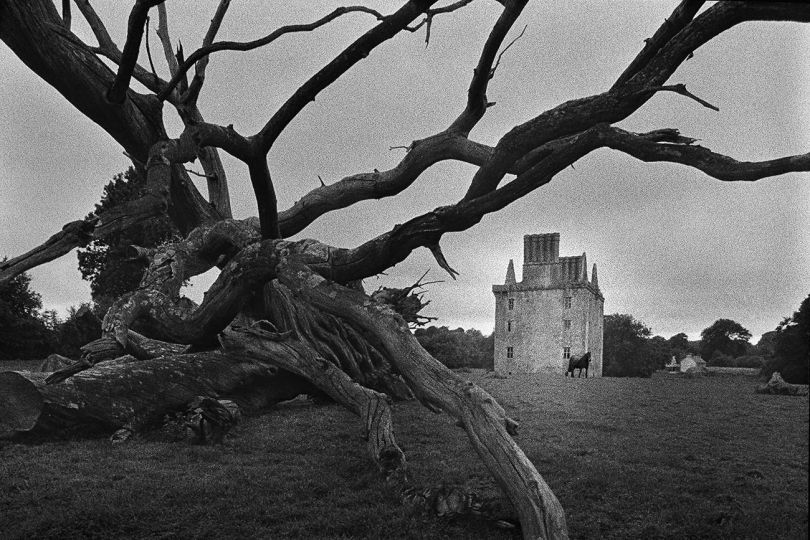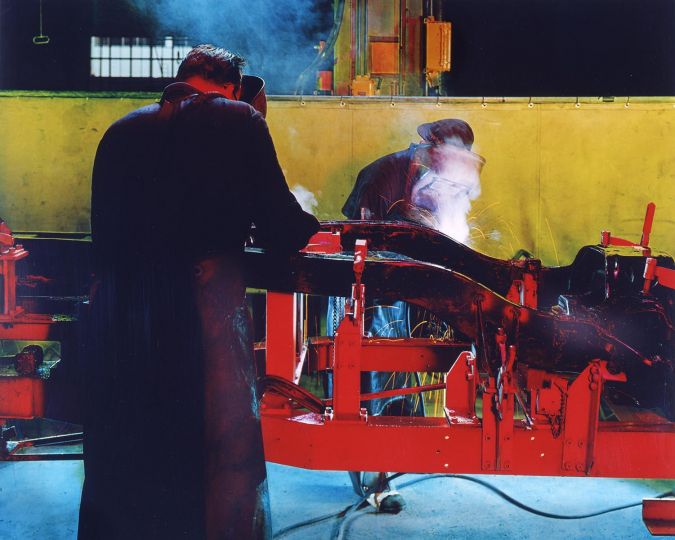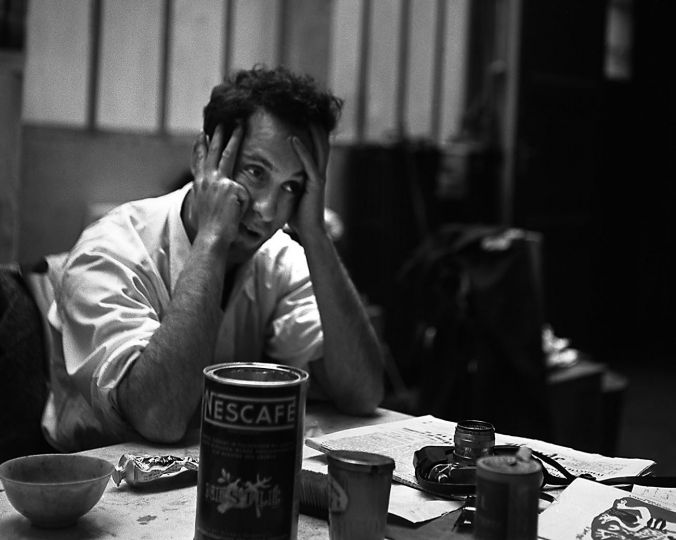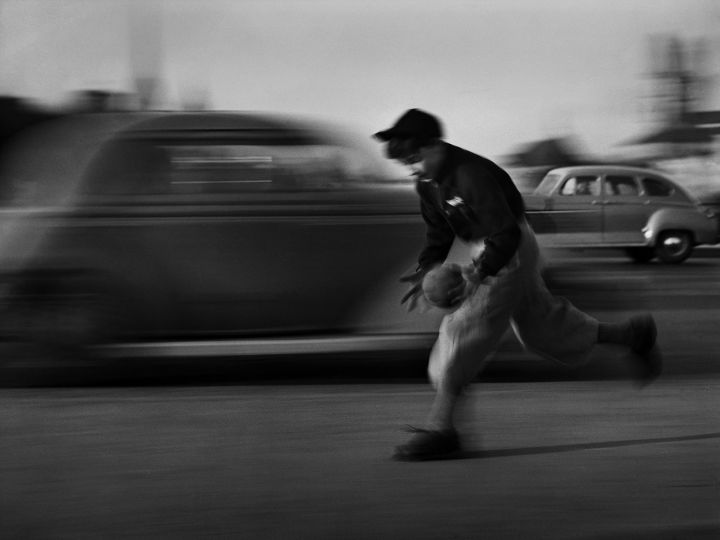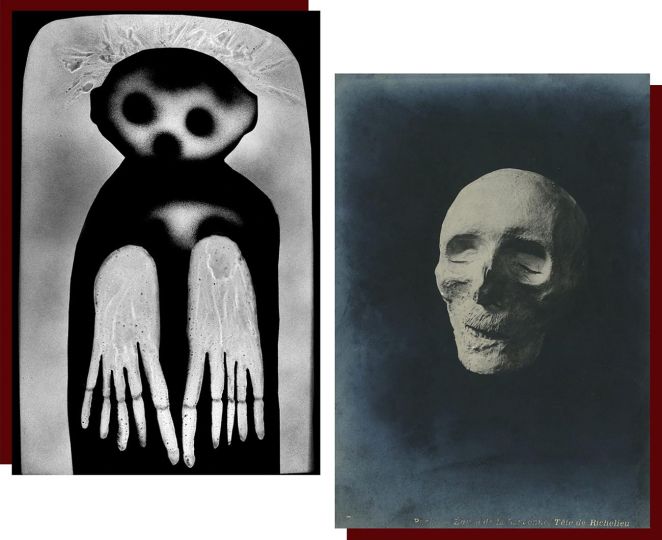Steven Poster is a cinematographer, best known for his work on Donnie Darko, Someone to Watch Over Me, and over fifty other features and TV shows. Less well known is his devotion to street photography. Poster is a lifelong still photographer with many museum and gallery shows that attest to his love of black and white photography. His stills work, seen here edgeofconsciousness.com is as different as you can imagine from his cinematography and yet both are informed by his vision of the right place and moment. Steven is also a devoted collector of the pictures of others. His home is filled with iconic images he has collected during his long career. They demonstrate his lifelong passion for images, both his and others’. We spoke at his home in the Hollywood Hills.
Andy Romanoff – What’s the first print you ever bought and how did you come to buy it?
Steven Poster – That’s it (pointing at a print over his head). I was working on a production in Toronto and married to a woman who was friends with the biggest photo dealer in Toronto, Jane Corcoran. We went over to her gallery on a Sunday and she started showing me her private collection. She showed me this picture and I asked her how much it was and she said twenty four hundred and I thought to myself well that’s much more affordable than I thought. We kept on looking at her prints and soon she came to another picture, an absolutely beautiful portrait of two women with their blonde hair flowing into each other and I asked what is that? She said it was a Man Ray and it was eighteen and again I thought “well that’s affordable”.
That night I ran into one of our actresses who was leaving town on Monday. She mentioned that she was looking for a present for her husband, a photographer, and I said “you know there’s a print of two women I think he would love” and I told her about where she could get it and that it was only eighteen hundred dollars… I told her that if she bought it to leave me a note under my door before she left. Monday night I came home to find a note that said “You’re absolutely right, it was a gorgeous picture but you were wrong about the price. It was eighteen thousand but I bought it anyway! So I called Jane Corcoran and said “How much was that Kertesz’ and she said “Twenty four hundred but since you made a sale for me I’ll give it for twenty one hundred.” So I bought it and that was the beginning of my collecting.
AR – What attracted you to this picture?
SP – Even though I wasn’t a collector I was attracted to certain photographers and Andre Kertesz was one of them. He was kind of the father of the type of street photography I was interested in shooting.
AR – Tell me about the pictures you were making at that time.
SP – Well, I was a budding street photographer. I had been shooting street since I was a teenager but I don’t think I understood it. I was attracted to walking around and observing and recording my observances.
AR – Were you aware of the work of other photographers?
SP – No. I found my way to the camera and I found my way to the kind of work I liked to do and only then learned that others were doing it.
AR – What drives you to collect? You make motion pictures, you shoot stills, your whole life is about photography and then on top of that you collect the work of others. What is that about?
SP – It’s just an extension of everything else I do. It’s allowing me see into the kind of history that street photography brings. What I collect for the most part is street photography, things I’ve always loved or things I’ve discovered along the way. For a long time I collected voraciously but it was always things I wanted to look at, things I wanted to inspire me on a daily basis. We tend to hang pictures and forget they are there, but I don’t. I sit back and look at my walls on a very regular basis. I look at this room and every room I’ve ever lived in as a canvas. I fill that canvas with images and parts of images, old familiar friends and work of photographers I’ve loved and the work of photographers who are just being discovered.
AR – Speaking of which I see some Vivian Maier on your wall.
SP –Well obviously we haven’t known Vivian Maier for a long time; she was just discovered a few years ago. But she is fascinating to me because some of my work was done at the same time and in the same place as her. I photographed and wandered around the same neighborhoods with my Rolleiflex as a kid at the same time as she was working. I became intrigued with her work as soon as I saw it. A friend told me to go online and look her up and I did and I just fell in love. Here was this photographer who did nothing but wander around with her Rolleiflex shooting black and white pictures in a lot of the areas I used to shoot in and she was unknown. And I couldn’t understand why she was unknown until I learned more about her. As I learned I got very involved with the people who were curating her stuff, I became sort of part of her family and I ended up with two of her prints, silver prints made in the fashion of the sixties. They have the feeling of that time, they are not contemporary.
AR – You talked about how these pictures inspire you as a still photographer. How does that then inform or influence you as a cinematographer?
SP – Even though they are completely different in form and in function, I don’t separate the two. For me, the act of making a photograph is emotionally similar whether I’m shooting motion pictures or I’m out on the street with my Leica. Of course in the one case I’m out there on my own with just a camera and with the other I may have a crew of a hundred working towards getting the image the way I want but when the pictures are actually being made there’s a kind of similarity to it.
AR – So then do you like to find your image as a cinematographer or do you like to create it?
SP – When I first started I was very technical but as I went on I worked very hard to move myself away from the technical and towards the intuitive, to work more the way I worked when I was street shooting. I think the first movie where I completely got there was Donnie Darko. I had worked towards that for a long time but Darko was the first time I thought I got there, where I had an intuitive sense of how to make a whole film like a photograph. That’s why when we made my book it was called Around the Edges. It’s not just what’s in the frame but about what’s around the edges of the frame. To me, it’s every element of every photograph; every element of each frame of a motion picture that informs the audience. What I’m doing when I’m shooting is telling a story, and I’m telling it emotionally whether I’m shooting a movie or I’m shooting stills.
AR – Going back to collecting, how many photographs do you own and how many have you collected in your career?
SP – I’ve probably owned a couple hundred pictures in my life. Right now I’m down to about a hundred. Some of them are anonymous, some of them are old French postcards, some of them are bits of things I’ve found but most of them are what you could call collector images. I have some vintage prints in my collection and I’m very proud of those. They have certainly increased the most in value. But I also have a lot of contemporary prints that are images I just want to live with. I knew them as a young photographer, I grew up with them and I just want to have them around. For instance the Cartier-Bresson prints are images of his that I knew and loved. I wanted to own them but couldn’t afford the vintage prints, so I bought contemporary prints.
Some of them are photographs made by friends of mine. For instance, the one of the boot, up near the ceiling, it’s from a very interesting series of photographs made by someone I went to college with, someone named Stephen Szabo who was a dear friend until he passed away. He’s collectable, he had many shows, but he died unfortunately at a very young age of MS. Now I remember him by having some of his photographs hanging in my house.
AR – What are you collecting now?
SP – Well my most recent acquisition is Vivian Maier. At the moment I’m looking more into photo books because I’m not really very excited by the state of contemporary photography. I think there’s almost a meanness about it, it seems meant more to shock, to get you through the crowd so your work gets noticed. I won’t say there’s a lack of purity to it but there seems to be a lack of heart.
We’re in a funny era where just about anybody can pick up their IPhone or their point and shoot and make credible images. In fact in Le Journal recently there was a story about that. It was US Press Review by Paul Melcher. The story was titled, “Who’s a Photographer?” and the opening sentence was “This question gets asked a lot these days.” It’s true; are we all photographers now or do some people just get lucky and if so, do I begrudge them, they may not have invested their life in photography and yet they are calling themselves photographers… No, it’s not for me to judge, I know that my life has been centered around photography since the time I was a teenager. I know that I still suck up everything I can find photographically. When I was in high school I hung around camera stores until they would hire me, when I was thirteen I visited my aunt and uncle who lived in Green Bay Wisconsin, and where did I spend my afternoons…hanging around the darkroom of the Green Bay Press Gazette. My mentor in Chicago was a man named Morry Blechman who was a CBS news cameraman. He owned the news film laboratory, Cinema Processors. I would go down there and listen to the guys tell stories about shooting news, anything I could do to bring me closer to photography. I read all the photo magazines end to end every month when they came out. At one point early on I was writing for Peterson’s Photographic about how to make home movies the Hollywood way. Every part of my life has been based on photography and I’ve been inspired by other photographers all along the way. I found it was important to purchase photographs and hang them on my walls, and spend my time looking at them again and again.
Andy Romanoff








